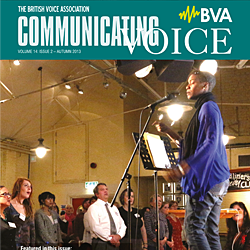About the Association
Van Lawrence Prize 2021
Comparing Aerosol Concentrations and Particle Size Distributions Generated by Singing, Speaking and Breathing at Rest – (abstract)
Natalie Watson
Introduction
The severe acute respiratory syndrome coronavirus 2 (SARS-CoV-2) pandemic resulted in an unprecedented shutdown in social and economic activity, with the cultural sector severely affected. Restrictions on musical performance arose from the perception that there was a higher risk of SARS-CoV-2 transmission from singing than speaking, based on high profile COVID-19 outbreaksfollowingchoral rehearsals.
Respiratory particulate matter is expelled during all human exhalatory events, with dropletsconsidered to be of sufficient mass to sediment with gravity, while aerosol particles remain airborne.To better inform both the decision makers and the public, and to help the performing artsindustry return to practice safely, we set up the PERFORM (The Investigation of ParticulatE Respiratory Matter to InForm Guidance for the Safe Distancing of PerfOrmeRs in a COVID-19 PandeMic) study group, to investigatethe number and mass concentrations of aerosol particles released at different levels of vocalisation and while breathing at rest.
A recent pre-print manuscript reported the greatest viral load of SARS-CoV-2 is found in respirable particles <5μm, supporting the importance of the PERFORM studies which focused on accurately measuring aerosol particles in this size range (Coleman et al.).In addition to the common mode that arises at ~0.7 μm diameter, produced by the distal airway tract during respiration, vocalisation releases larger particles than breathing at rest, of a second larger mode at~1.7μm diameter generated by the larynx(Johnson & Johnson).In addition, an effort dependence is recognised in the concentration of aerosol particles released during vocalisation (Asadiet al.). Our hypothesis was thatthe number and mass concentrations in respirable aerosol particles between singing and speaking were not different.
Methods
We measured respirable particles (size range 0.5 – 20μm diameter)using an aerodynamic particle sizer (APS, Model 3321, TSI Inc.) to quantify the numberconcentration and size distribution of respirable particles generated during breathing, speakingsinging and coughing. The measurements were conducted in a laminar flow orthopaedic operating theatre, with a near-zero background aerosol concentrationthat allowed us to unequivocally attribute the respirable particlesdetected to a specific expiratory activity.
A standard operating procedure was adopted covering 12 activities lasting∼1 h, with each activity involving up to 5 repeat actions, punctuated by 30 second pauses. Participants performed activitiesincludingsustainedvocalisation of single notes (“/ɑ/”) at different pitches, and speaking and singing the “Happy Birthday” song at different loudness and within their vocal range. The Public Health England Research Ethics and Governance of Public Health Practice Group (PHE REGG) approved this study.Informed consent was obtained from all participants, with pre-screening and lateral flow testsperformedto ensure each was healthyat the time of testing.
Results: Professional adult singer cohort(n=25):13 female, 12 male, mean age 38 (range 22 to 57), vocal range from bassto soprano. Singing and speaking both showed steep increases in number and mass concentration with increasing sound level (spanning a factor of 20–30 across the dynamic range measured; p<0.001). At the quietest volume (50 – 60 dBA), neither singing (p=0.19) nor speaking (p=0.20) were different to breathing. At the loudest volume (90 – 100 dBA), a difference was observed between singing and speaking but with singing only generating a factor of between 1.5 and 3.4 more aerosol mass than speaking (p<0.001).Child singers (n=18):9 female, 9 male, mean age 13(range 12 to 14), 2 to 20 hours of singing practice a week, centile range 11-99 (mean 57.9 centile), vocal range fromtenor totreble. Time averaged number and mass concentrations ofexpired particles measured during speaking and singing from both boys and girls show high correlations with increasingloudness of vocalization, consistent with adult singers performing the same expiratory activities at the same sound volumes.Comparing the children with the adult cohort at 70-80dBA, in both speaking and singing there was no difference in number (p=0.9 and p=0.23, respectively) or mass (p=0.09 and p=0.561, respectively) concentration of respirable particles.
Conclusion
Guidelines for musical performances should be based on the loudness and duration of the vocalisation, the number of participants and the environment in which the activity occurs, rather than the type of vocalisation. Simultaneous number and mass concentrations of expired particulate aerosols from the APS measurements and the sound level recording demonstrate that the dynamics of expired particle release during speaking and singing are highly correlated with the loudness.No difference was found between children and adults in speaking and singing at 70-80dBA, suggesting that the mass and number concentration of respirable particles for these vocalisations is not determined by the size or age of individual but is task-effort dependent. Mitigations, including the use of amplification and increased attention to ventilation should be employed where practicable.

 Join us Now!
Join us Now! our newsletter
our newsletter free voice care leaflets & information – download here
free voice care leaflets & information – download here Help our work by donating while you shop
Help our work by donating while you shop